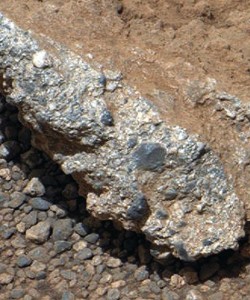
By Morgan Kelly, Office of Communications
Pebbles and sand scattered near an ancient Martian river network may present the most convincing evidence yet that the frigid deserts of the Red Planet were once a habitable environment traversed by flowing water.
Scientists with NASA’s Mars Science Laboratory mission reported May 30 in the journal Science the discovery of sand grains and small stones that bear the telltale roundness of river stones and are too heavy to have been moved by wind. The researchers estimated that the sediment was produced by water that moved at a speed between that of a small stream and a large river, and had a depth of roughly an inch to nearly 3 feet.
Co-author Kevin Lewis, a Princeton associate research scholar in geosciences and a participating scientist on the Mars mission, said that the rocks and sand are among the best evidence so far that water once flowed on Mars, and suggest that the planet’s past climate was wildly different from what it is today.
“This is one of the best pieces of evidence we’ve seen on the ground for flowing water,” Lewis said. “The shape of these rocks and sand is exactly the same kind of thing you’d see if you went out to any streambed. It suggests a very similar environment to the Earth’s.”
The researchers analyzed sediment taken from a Martian plain that abuts a sedimentary deposit known as an alluvial fan. Alluvial fans are comprised of sediment leftover when a river spreads out over a plain then dries up, and are common on Earth in arid regions such as Death Valley.
Yet Death Valley is a refreshing spring compared to Mars today, Lewis said. Satellite images taken in preparation for the 2012 landing of NASA’s Curiosity Mars rover had revealed ancient river channels carved into the land on and around Mount Sharp, a 3.5-mile high mound similar in size to Alaska’s Mt. McKinley that would become the rover’s landing site. A major objective of the Curiosity mission is to explore Mars’ past habitability.
Nonetheless, liquid water itself is most likely rare on Mars’ currently cold and dusty landscape where wind is the dominant force. Lewis was co-author on a paper in the May 2013 edition of the journal Geology that suggested that Mount Sharp, thought to be the remnant of a massive lake, is most likely a giant dust pile produced by Mars’ violent, swirling winds.
Strong as it might be, however, wind cannot move sediment grains with a diameter larger than a few millimeters, Lewis said. The sand and stones he and his colleagues analyzed had diameters ranging from one to 40 millimeters, or roughly the size of a mustard seed to being only slightly smaller than a golf ball. The roundness of the sediment also suggested a prolonged eroding force, Lewis said.
“Once you get above a couple of millimeters the wind will not be able to mobilize sediment. A number of the grains we see in this outcrop are substantially bigger than that,” Lewis said. “That really leaves us with fluvial transport as the most likely process. We knew Curiosity was landing near the fan, but to land right on top of these rocks that suggest the presence of water was really fortuitous.”
If the sediment does mean a river ran through Mars, the researchers must next determine when, where it came from and how it dried up, a project that will be a “major scientific project over the coming year,” Lewis said. The mystery also centers on the potential relationship of the river to the scars on Mount Sharp: Did the river flow down it? Was the mound a source of water after all?
“This evidence tells us that there were a diverse set of geological processes happening at roughly the same time within the proximity of [the landing site], and it gives us a picture of a much more dynamic Mars than we see today,” Lewis said. “Finding out how exactly they relate will be an exciting story.”
Citation: Williams, R.M.E., et al. 2013. Martian fluvial conglomerates at Gale Crater. Science. Article first published online: May. 30, 2013. DOI: 10.1126/science.1237317
This work was supported in part by grants from NASA Mars Program Office.

You must be logged in to post a comment.